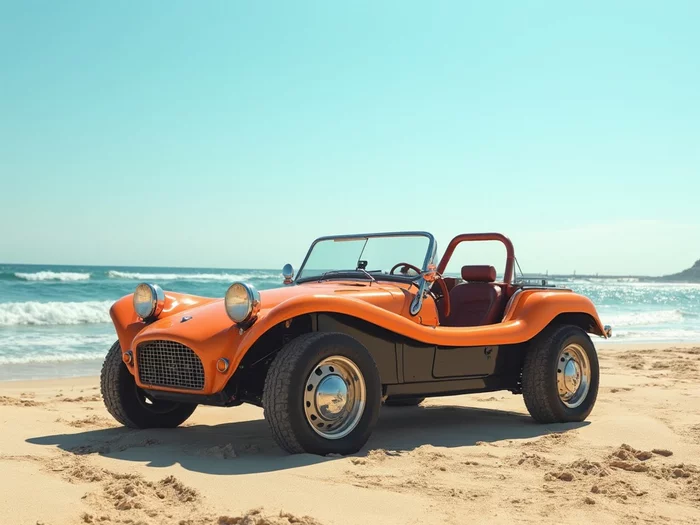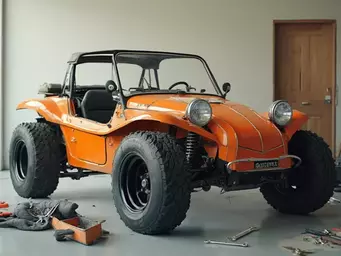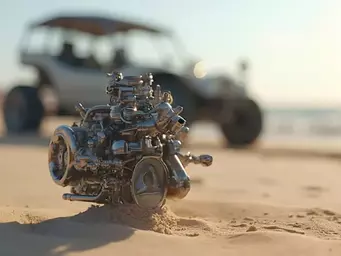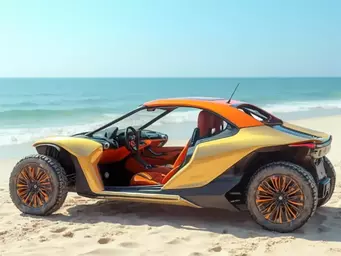Phase 1: Initial Assessment
Thoroughly inspect chassis, body panels, and mechanicals for rust, damage, and functionality.
Get the latest beach buggy build guides, restoration tips, and performance upgrades delivered directly to you.
Posted on: 2025-10-14
By: Jasper Quinn
Have you ever felt the thrill of restoring a classic vehicle to its former glory? The journey of beach buggy restoration is not just about mechanics; it's a personal adventure filled with creativity, craftsmanship, and community. Here’s what you can expect to learn through this rewarding process.
This visual outlines the crucial phases and essential tips involved in restoring a classic beach buggy, from initial assessment to celebrating accomplishments.
Thoroughly inspect chassis, body panels, and mechanicals for rust, damage, and functionality.
Quality wrenches, sanders, paint sprayer, and safety gear are crucial for efficiency.
Ensure a clean, well-lit, and ventilated area for both safety and efficiency.
Identify rust types (surface vs. deep) and apply appropriate repair techniques like fiberglass.
Cleaning, sanding, and priming are vital for a flawless paint finish. Patience is key here.
Document your journey with before-and-after photos, and connect with fellow enthusiasts.
Restoring a classic beach buggy is more than just a project; it’s a journey of passion that brings enthusiasts closer to their vehicles and the exhilarating beach culture. With its unique charm and vibrant history, a beach buggy isn't just a mode of transport—it's a canvas for creativity and a connection to the past. Every dent, every patch of rust, tells a story waiting to be revitalized.
Moreover, restoring one of these beauties allows you to appreciate craftsmanship and learn valuable skills along the way. There's immense satisfaction in breathing new life into an old chassis, making it a thrilling ride for years to come!
The allure of a classic beach buggy restoration lies in the blend of nostalgia and innovation. These iconic vehicles are not just for show; they are a testament to the automotive spirit that thrives in Australia. Restoring a beach buggy means you’re embracing a lifestyle characterized by adventure, fun, and a close-knit community of enthusiasts.
Each of these aspects adds layers of meaning to your restoration journey, making it a rewarding experience that goes beyond just the mechanical work involved.
Before diving into the restoration work, it's crucial to assess your beach buggy's current state thoroughly. This evaluation helps identify which areas require immediate attention and what parts can be salvaged. Begin by inspecting the chassis for rust, structural integrity, and any signs of previous repairs.
Documenting these findings will guide you in planning your restoration process. Plus, sharing this journey with others can inspire new DIY enthusiasts to take their first steps into this exciting hobby! For a comprehensive guide on restoring classic vehicles, insights from the Manx Club restoration guide can be particularly useful.
Equipping yourself with the right tools and materials is essential for an effective restoration. Investing in quality items can make a significant difference in the outcome of your project. Here’s a list of essentials to get you started:
By collecting high-quality tools, you set the stage for a more efficient, enjoyable restoration process. Trust me, it’ll pay off in the long run!
A well-organized workspace can drastically affect your restoration experience. Ensure your area is clean, well-lit, and well-ventilated to avoid any mishaps while working with chemicals or tools. It’s crucial to have a space that prioritizes both safety and efficiency.
These simple setups can keep you focused and safe, allowing you to enjoy every moment of your restoration adventure!
Rust is often the enemy of classic vehicles, but with the right techniques, it can be managed effectively. Start by assessing the extent of the rust and determining whether a simple patch, a replacement panel, or a more extensive repair is necessary. You can use fiberglass for areas that require strength and flexibility. For detailed discussions on rust repair techniques, online communities like Beach Buggy Info forums offer valuable insights.
Taking your time with rust repair ensures that your beach buggy remains strong and visually appealing for many years to come.
Your paint job will only be as good as the surface beneath it! Thorough surface preparation involves sanding, cleaning, and priming before any paint is applied. This foundational step is vital for achieving a flawless finish.
Remember, patience in this phase pays off when you see the final result shine on your beach buggy!
As you embark on your beach buggy restoration journey, what aspect excites you the most? Is it the creative customization, the technical challenges, or the community engagement? Let us know below:
After months of hard work and dedication, it’s time to take a moment to celebrate your accomplishments in beach buggy restoration! Whether you’ve transformed a rusted chassis into a gleaming masterpiece or revamped the paintwork to capture that vintage vibe, it's essential to appreciate the journey. Every step you’ve taken has contributed to a unique narrative, filled with challenges and triumphs. Take a breather and relish the fact that you brought a piece of automotive history back to life!
As you admire your hard work, consider showcasing the transformation of your classic beach buggy. Before-and-after photos can be incredibly rewarding, not just for you, but for fellow enthusiasts who might be inspired by your efforts. Documenting your journey adds a personal touch and highlights the satisfaction that comes with restoration!
Sharing your transformation story can inspire others in the community to take on their own restoration projects. Remember, your unique experience might just encourage someone else to dive headfirst into the world of beach buggies!
Now that your beach buggy is road-ready, it’s time to connect with other enthusiasts. Join forums, local clubs, or social media groups dedicated to classic car restoration. Sharing your tips, experiences, and challenges fosters a sense of community and enriches the restoration journey for everyone involved!
Don’t hesitate to ask questions in these spaces—chances are, someone else has faced similar challenges. Whether it’s about sourcing parts or techniques in restoration, the collective knowledge of fellow beach buggy enthusiasts is invaluable!
Don’t underestimate the value of reaching out to restoration shops and online forums. These resources can provide expert advice and services that can elevate your restoration skills. Many shops specialize in vintage and classic vehicles, offering insights that can help refine your techniques and results.
Engaging with professionals and fellow hobbyists not only enhances your skillset but also opens doors to new opportunities within the beach buggy community. Embrace the connections and continue learning—your journey doesn’t end with restoration!
The primary benefit is the preservation of automotive history, allowing these classic vehicles to remain a part of our culture, coupled with the opportunity for creative expression and skill development.
Initial steps involve a thorough inspection of the chassis for rust and structural integrity, checking body panels for damage, and evaluating mechanical components like the engine, transmission, and suspension for functionality.
Essential tools include wrenches and sockets for disassembly, sanders and buffers for surface preparation, a paint sprayer for even application, and comprehensive safety gear like goggles, gloves, and respirators.
Workspace preparation is crucial for safety and efficiency. A clean, well-lit, and well-ventilated area with proper tool organization prevents mishaps and allows for focused work, especially when dealing with chemicals or tools.
For rust repair, it's important to identify the type of rust (surface vs. deep). Techniques include sanding away surface rust, cutting out deeper rust, using rust converters for small patches, and applying fiberglass for durable, lightweight solutions in certain areas.
Here is a quick recap of the important points discussed in the article:

 What if every turn of the wrench not only transformed your beach buggy but also deepened your passio
What if every turn of the wrench not only transformed your beach buggy but also deepened your passio
 Upgrading your beach buggy isn't just about power—it's a journey towards better performance and en
Upgrading your beach buggy isn't just about power—it's a journey towards better performance and en
 Have you ever felt the thrill of cruising along the shore in a custom beach buggy, the sun warming y
Have you ever felt the thrill of cruising along the shore in a custom beach buggy, the sun warming y